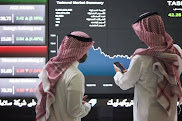Global stocks sunk, a day after US President Donald Trump
announced sweeping new tariffs that are forecast to raise prices and weigh on
growth in the United States and around the world, reports the Saudi Gazette.
Stock markets in the Asia-Pacific region fell for a second
day, hot on the heels of the S&P 500, which had its worst day since Covid
crashed the economy in 2020. Nike, Apple and Target were among big consumer
names worst hit, all of them sinking by more than 9%.
At the White House, Trump told reporters the US economy
would "boom" thanks to the minimum 10% tariff he plans to slap on
global imports in the hope of boosting federal revenues and bringing American
manufacturing home.
The Republican president plans to hit products from dozens
of other countries with far higher levies, including trade partners such as
China and the European Union.
China, which is facing an aggregate 54% tariff, and the EU, which faces duties
of 20%, both vowed retaliation on Thursday. French President Emmanuel Macron
called for European firms to suspend planned investment in the United States.
Tariffs
are taxes on goods imported from other countries, and Trump's plan that he
announced on Wednesday would hike such duties to some of the highest levels in
more than 100 years.
In morning trading on Friday, Japan's benchmark Nikkei 225
index fell by 2.7% and Australia's ASX 200 was down by 1.6%. The Kospi in South
Korea was flat to slightly lower. Markets in mainland China and Hong Kong were
closed for the Qingming Festival.
Earlier on Thursday, the S&P 500 — which tracks 500 of
the biggest American firms — plunged 4.8%, shedding roughly US$2 trillion in
value. The Dow Jones closed about 4% lower, while the Nasdaq tumbled roughly
6%. The US shares sell-off has been going on since mid-February amid trade war
fears.
Britain’s FTSE 100 share index dropped 1.5% and other
European markets also fell, echoing declines from Japan to Hong Kong.
On Thursday at the White House, Trump doubled down on a
high-stakes gambit aimed at reversing decades of US-led liberalization that shaped
the global trade order.
"I think it's going very well," he said. "It
was an operation like when a patient gets operated on, and it's a big thing. I
said this would exactly be the way it is."
He added, "The markets are going to boom. The stock is
going to boom. The country is going to boom."
Contradicting White House aides who insisted the new tariffs
were not a negotiating tactic, Trump signalled he might be open to a deal with
trade partners "if somebody said we're going to give you something that's
so phenomenal".
On Thursday, Canada's Prime Minister Mark Carney said that
country would retaliate with a 25% levy on vehicles imported from the US.
Trump last month imposed tariffs of 25% on Canada and
Mexico, though he did not announce any new duties on Wednesday against the North
American trade partners.
Firms now face a choice of swallowing the tariff cost,
working with partners to share that burden, or passing it on to consumers — and
risking a drop in sales.
That could have a major impact as US consumer spending
amounts to about 10% to 15% of the world economy, according to some estimates.
While stocks fell on Thursday, the price of gold, which is
seen as a safer asset in times of turbulence, touched a record high of US$3,167.57
an ounce at one point on Thursday, before falling back.
The dollar also weakened against many other currencies.
In Europe, the tariffs could drag down growth by nearly a
percentage point, with a further hit if the bloc retaliates, according to analysts
at Principal Asset Management.
In the US, a recession is likely to materialize without
other changes, such as big tax cuts, which Trump has also promised, warned
Seema Shah, chief global strategist at the firm. She said Trump's goals of
boosting manufacturing would be a years-long process "if it happens at
all".
"In the meantime, the steep tariffs on imports are
likely to be an immediate drag on the economy, with limited short-term
benefit," she said.
On Thursday, Stellantis, which makes Jeep, Fiat and other
brands, said it was temporarily halting production at a factory in Toluca,
Mexico and Windsor, Canada. It said the move, a response to Trump's 25% tax on
car imports, would also lead to temporary layoffs of 900 people at five plants
in the US that supply those factories.
Nike, which makes much of its sportswear in Asia, was among
the hardest hit on the S&P, with shares down 14%. Shares in Apple, which
relies heavily on China and Taiwan, tumbled 9%. Other retailers also fell, with
Target down roughly 10%.
Motorbike maker Harley-Davidson – which was subject of
retaliatory tariffs by the EU during Trump's first term as president – fell
10%.
In Europe, shares in sportswear firm Adidas fell more than
10%, while stocks in rival Puma tumbled more than 9%.
"You're seeing retailers get destroyed right now because tariffs extended
to countries we did not expect," said Jay Woods, chief global strategy at
Freedom Capital Markets, adding that he expected more turbulence ahead.






